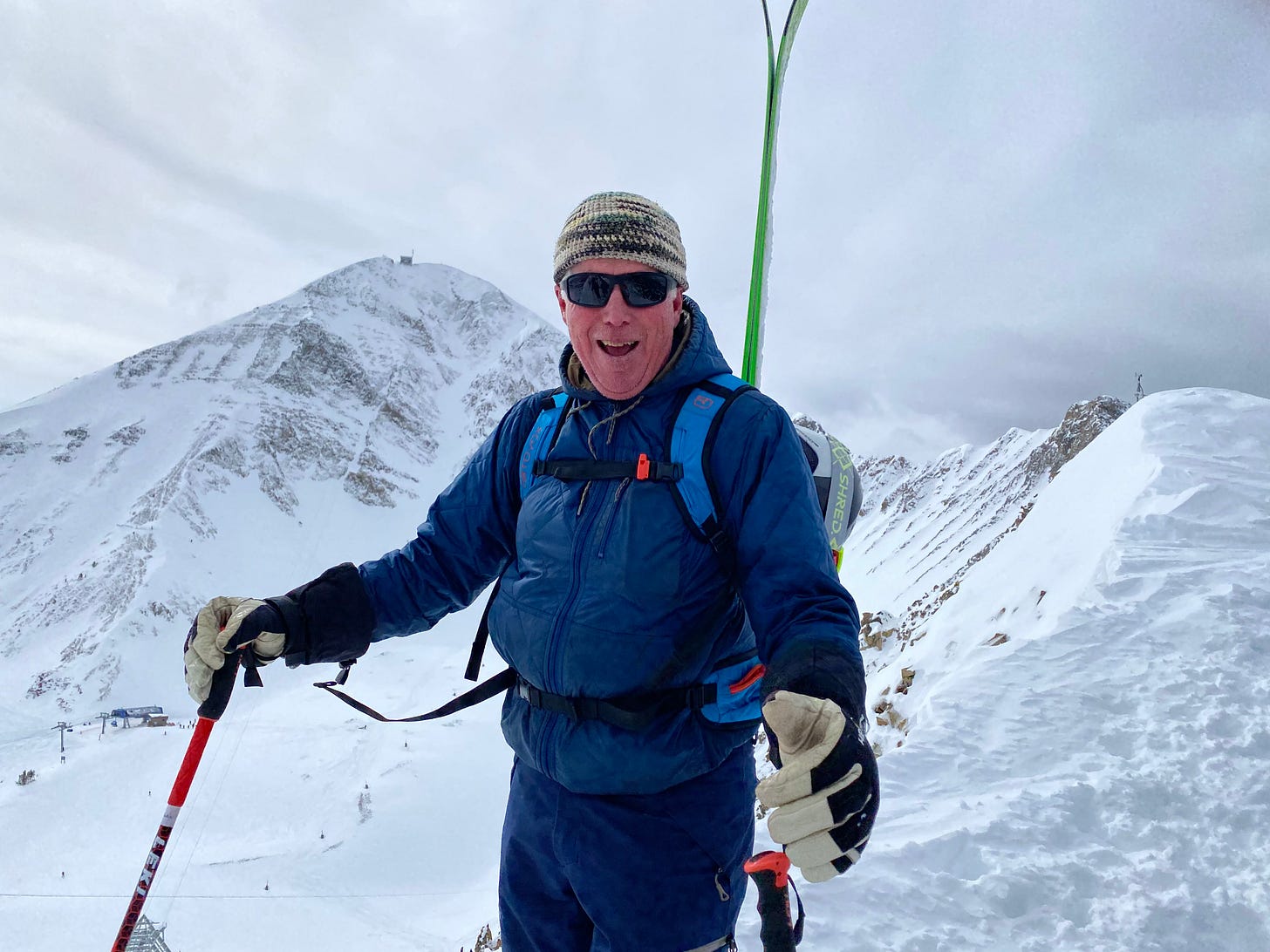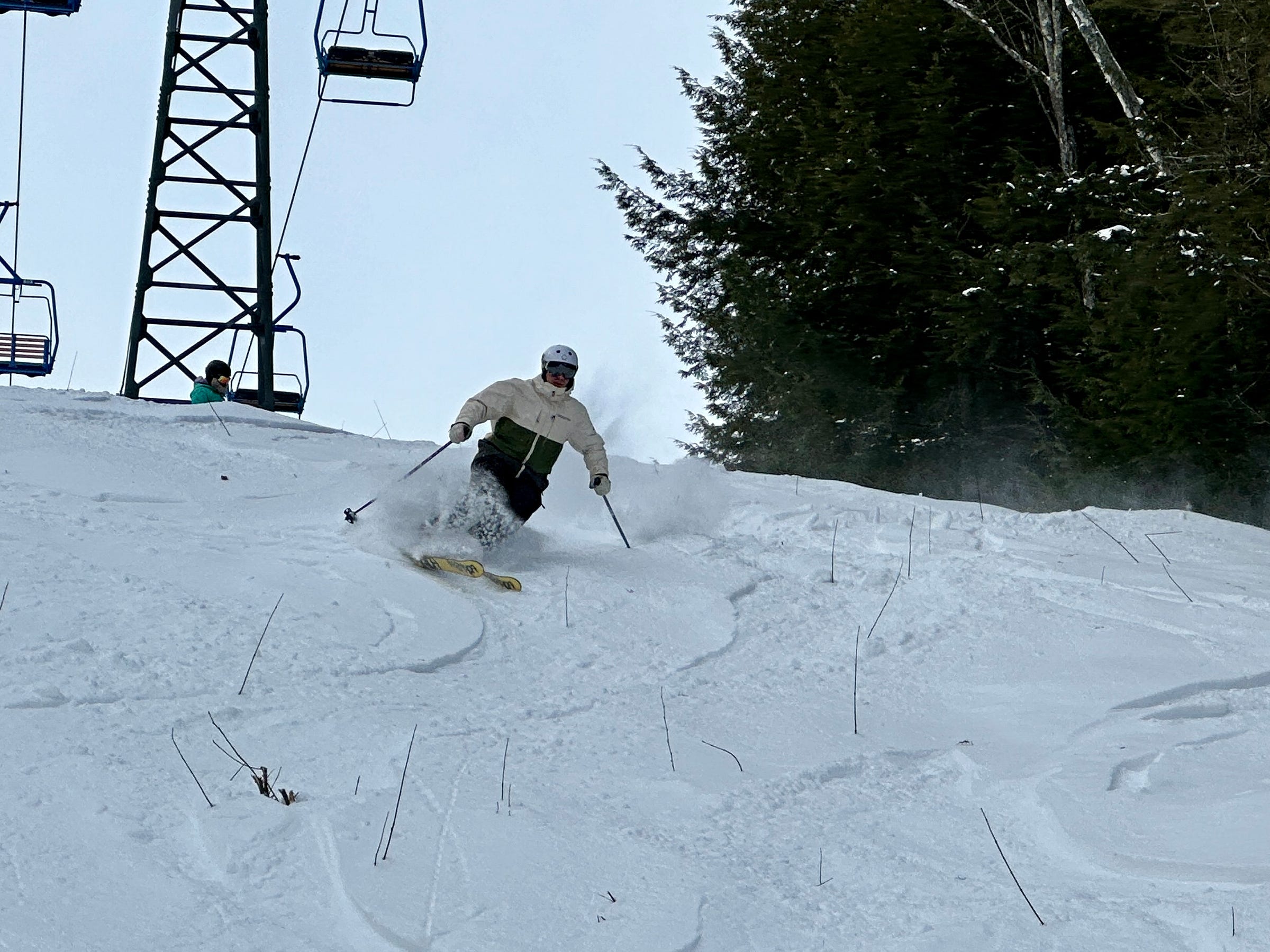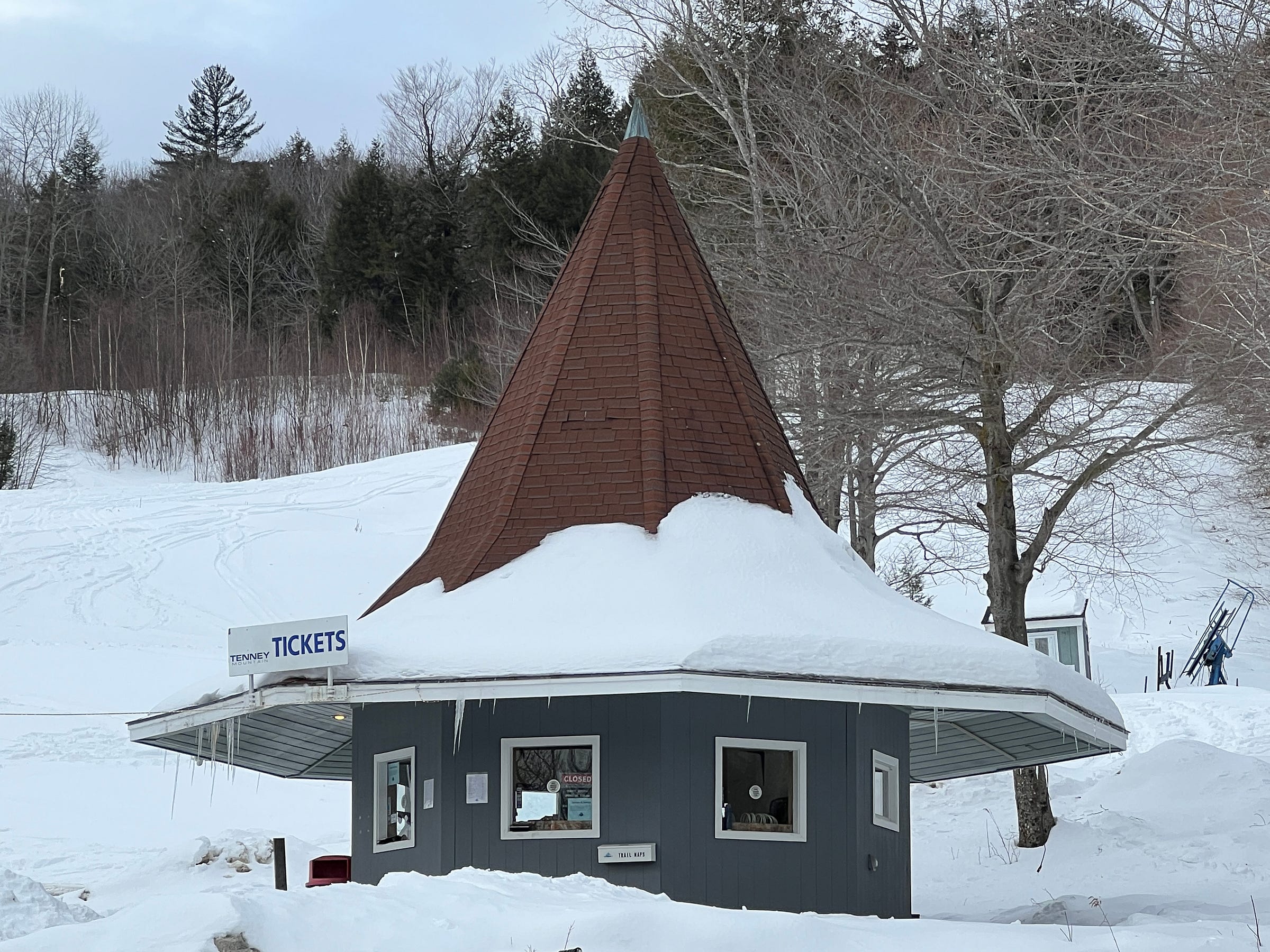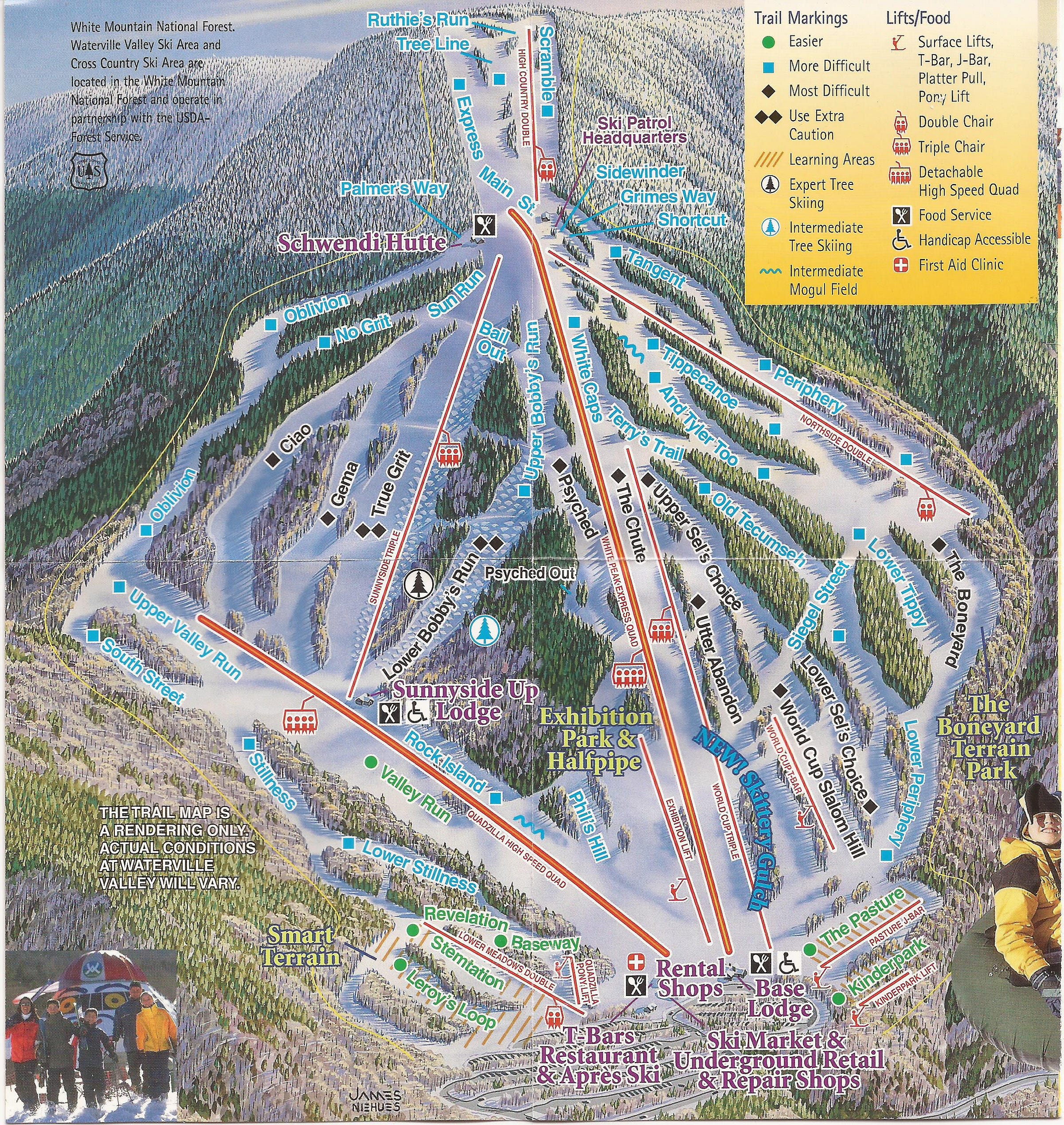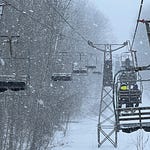Who
Dan Egan, General Manager of Tenney Mountain, New Hampshire
Recorded on
March 14, 2024
About Tenney Mountain
Owned by: North Country Development Group
Located in: Plymouth, New Hampshire
Year founded: 1960 (closed several times; re-opened most recently in 2023)
Pass affiliations:
No Boundaries Pass: 1-3 days, no blackouts
Closest neighboring ski areas: Campton (:24), Kanc Recreation Area (:33), Loon (:34), Ragged (:34), Waterville Valley (:35), Veteran’s Memorial (:39), Red Hill Ski Club (:42), Cannon (:44), Proctor (:44), Mt. Eustis (:50), Gunstock (:52), Dartmouth Skiway (:54), Whaleback (:55), Storrs (:57), Bretton Woods (:59)
Base elevation: 749 feet
Summit elevation: 2,149 feet
Vertical drop: 1,400 feet
Skiable Acres: 110 acres
Average annual snowfall: 140 inches
Trail count: 47 (14 advanced, 27 intermediate, 6 beginner) + 1 terrain park
Lift count: 3 (1 triple, 1 double, 1 platter - view Lift Blog’s inventory of Tenney’s lift fleet)
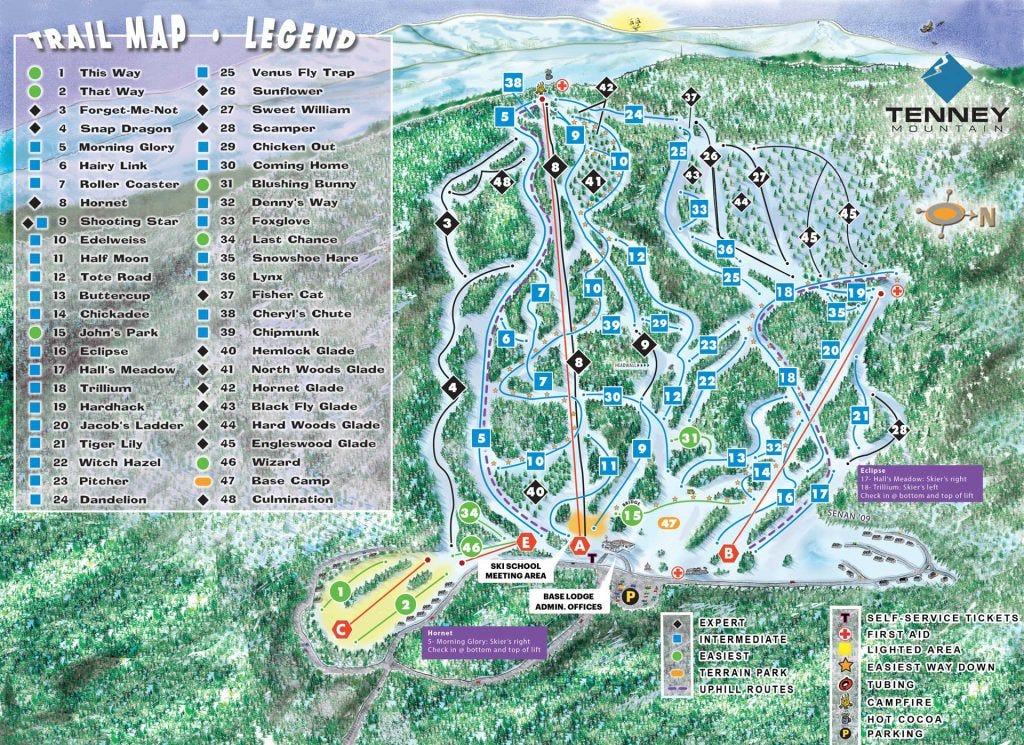
View historic Tenney Mountain trailmaps on skimap.org.
Why I interviewed him
Dan Egan is an interesting guy. He seems to have 10 jobs all at once. He’s at Big Sky and he’s at Val-d’Isère and he’s writing books and he’s giving speeches and he’s running Tenney Mountain. He’s a legendary freeskier who didn’t die young and who’s stayed glued to the sport. He loves skiing and it is his whole life and that’s clear in talking to him for 30 seconds.
So he would have been a great and compelling interview even outside of the context of Tenney. But I’m always drawn to people who do particular, peculiar things when they could do anything. There’s no reason that Dan Egan has to bother with Tenney, a mid-sized mountain in a mid-sized ski state far from the ski poles of the Alps and the Rockies. It would be a little like Barack Obama running for drain commissioner of Gladwin County, Michigan. He’d probably do a good job, but why would he bother, when he could do just about anything else in the world?
I don’t know. It’s funny. But Egan is drawn to this place. It’s his second time running Tenney. The guy is Boston-core, his New England roots clear and proud. It makes sense that he would rep the region. But there are New England ski areas that stand up to the West in scope and scale of terrain, and even, in Northern Vermont, snow volume and quality (if not consistency). But Tenney isn’t one of them. It’s like the 50th best ski area in the Northeast, not because it couldn’t be better, but because it’s never been able to figure out how to become the best version of itself.
Egan – who, it’s important to note, will move into an advisory or consultant role for Tenney next winter – seems to know exactly who he is, and that helps. He understands skiing and he understands skiers and he understands where this quirky little mountain could fit into the wide world of skiing. This is exactly what the ski area needs as it chugs into the most recent version of itself, one that, we hope, can defy its own legacy and land, like Egan always seems to, on its skis.
What we talked about
A vision for Tenney; what happened when Egan went skiing in jeans all over New Hampshire; the second comeback season was stronger than the first; where Tenney can fit in a jam-packed New Hampshire ski scene; why this time is different at Tenney; the crazy gene; running a ski area with an extreme skier’s mindset; expansion potential; what’s lost with better snowmaking and grooming and wider trails; why New England breeds kick-ass skiers; Tenney’s quiet renovation; can Tenney thrive long-term with a double chair as its summit lift?; what’s the worst thing about a six-person chair?; where Tenney could build more beginner terrain; expansion opportunities; the future of the triple chair; an endorsement for surface lifts; the potential for night skiing; the difference between running Tenney in 2002 and 2024; the slow death of learn-to-ski; why is skiing discounting to its most avid fans?; the down side of online ticket discounts; warm-weather snowmaking; Tenney’s snowmaking evolution; the best snowmaking system in New Hampshire; “any ski area that’s charging more than $100 for skiing and then asking you to put your boots in a cubby outside in the freezing cold … to me, that’s an insult”; the importance of base lodges; “brown-baggers, please, you’re welcome at Tenney”; potential real estate development and the importance of community; New England ski culture – “It means something to be from the East”; “why aren’t more ski area operators skiing?”; skiing as confidence-builder; the No Boundaries Pass; the Indy Pass; Tenney season pass pricing; and Ragged’s Mission: Affordable pass.
Why I thought that now was a good time for this interview
In late 2022, as Tenney’s social media feeds filled with hyperactive projects to re-open the ski area, I asked a veteran operator – I won’t say which one – what they thought of the ski area’s comeback potential.
“No chance,” they’d said, pointing to lack of water, strained and dated infrastructure, and a mature and modern competitive marketplace. “They’re insane.”
And yet, here we are. Tenney lives.
The longer I do this, the less the project of operating a ski area makes sense to me. Ski areas, in my head, have always been Mount Bohemia: string a lift up the mountain and let the skiers ride. But that model can only work in like four places on the continent, and sometimes, like this year, it barely works there. The capital and labor requirements of running even a modest operation in schizophrenic New England weather are, by themselves, shocking. Add in a summit lift built six decades ago by a defunct company in an analogue world, an already overcrowded New Hampshire ski market, and a decades-long legacy of failure, and you have an impossible-seeming project.
But they’re doing it. For two consecutive winters, lift-served snowskiing has happened at Tenney. The model here echoes the strategy that has worked at Titus and Holiday Mountain and Montage: find an owner who runs other successful, non-ski businesses and let those businesses subsidize the ski area until it can function independently. That could take a while. But Steven Kelly, whose Timberline Construction Company is big-timing it all over New England, seems committed.
Some parts of the country, like Washington, need more ski areas. Others, like New Hampshire, probably have too many. That can be great for skiers: access road death matches are not really a thing out here, and there’s always some uncrowded bump to escape to on peak days. Operators competing for skiers, however, have a tricky story to tell. In Tenney’s case, the puzzle is this: how does a fixed-grip 1,400-footer compete in a crowded ski corridor in a crowded ski state with five-dollar Epic Passes raining from the skies and Octopus lifts rising right outside of town and skiers following habits and rituals formed in childhood? Tenney’s operators have ideas. And some pretty good ones, as it turns out.
Questions I wish I’d asked
I know some of you will be disappointed that I didn’t get into Egan’s career as a pro skier. But this interview could have been nine hours long and we wouldn’t have dented the life of what is a very interesting dude. Anyway here’s Egan skiing and talking about skiing if you were missing that:
What I got wrong
We recorded this before 2024-25 Tenney season passes dropped. Egan teased that they would cost less than 2023-24 passes, and they ended up debuting for $399 adult, down from $449 for this past winter.
When describing the benefits of nearby Ragged Mountain’s $429 season pass, I mention the ski area’s high-speed lifts and extensive glades, but I neglected to mention one very important benefit: the pass comes loaded with five lift tickets to Jay freaking Peak.
Why you should ski Tenney
Before high-speed lifts and Colorado-based owners and Extreme Ultimo Megapasses, there was a lot more weird in New England skiing. There was the Cranmore Skimobile:
And these oil-dripping bubble doubles and rocket-ship tram at Mount Snow:
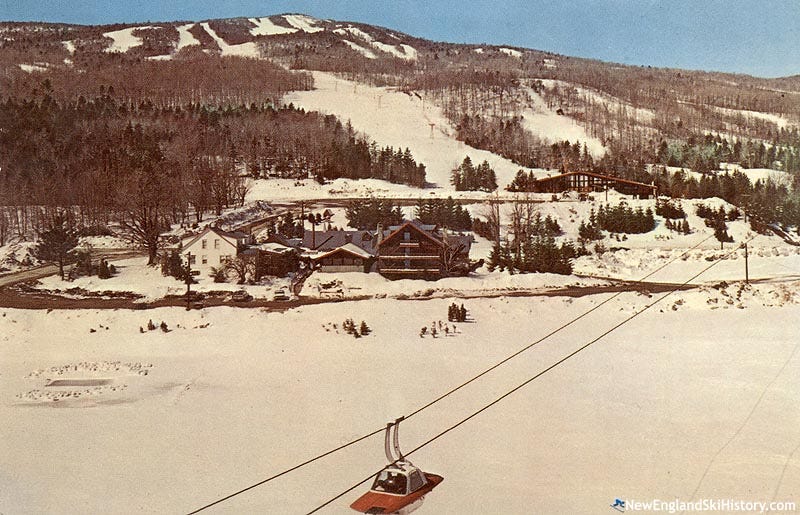
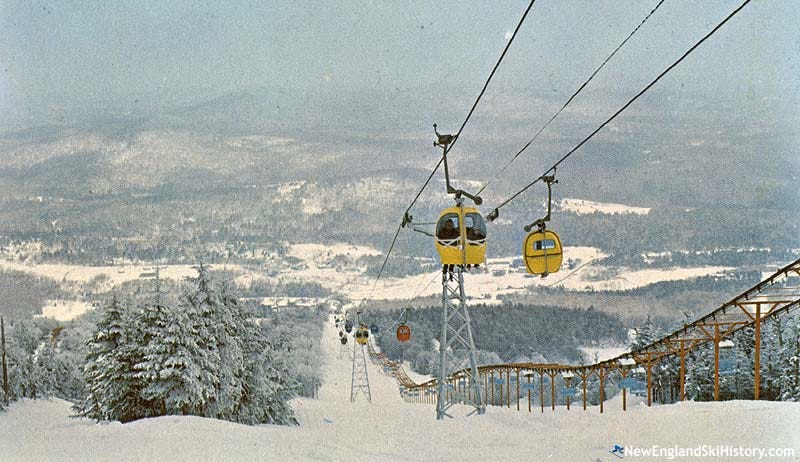
And whatever the hell is going on here at now-defunct King Ridge, New Hampshire:
I don’t really know if all this was roadside carnival schtick or regional quirk or just a reflection of the contemporary world, but it’s all mostly gone now, a casualty of an industry that’s figured itself out.
Which is why it’s so jarring, but also so novel and so right, to pull into Tenney and to see this:
I don’t really know the story here, and I didn’t ask Egan about it. They call it the Witch’s Hat. It’s Tenney’s ticket office. Perhaps its peculiar shape is a coincidence, the product of some long-gone foreman’s idiosyncratic imagination. I don’t even know why a ski area with a base lodge the size of Rhode Island bothers to maintain a separate building just for selling lift tickets. But they do. And it’s wonderful.
The whole experience of skiing Tenney evokes this kind of time-machine dislocation. There’s the lattice-towered Hornet double, a plodding 60-year-old machine that moves uphill at the pace of a pack mule:

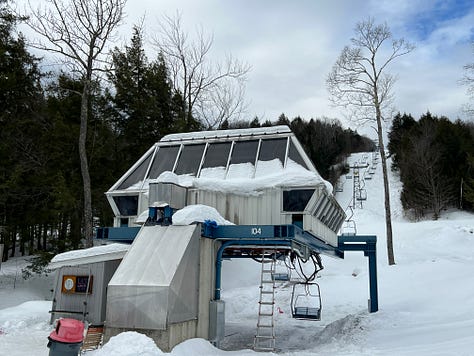
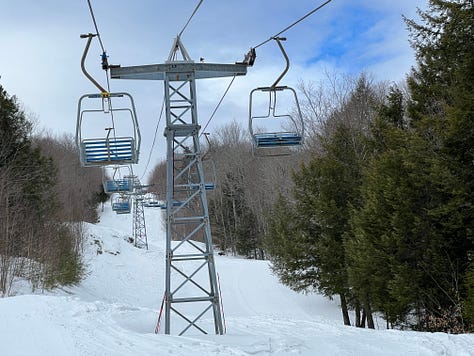
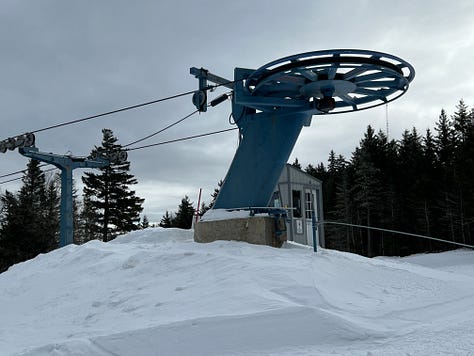


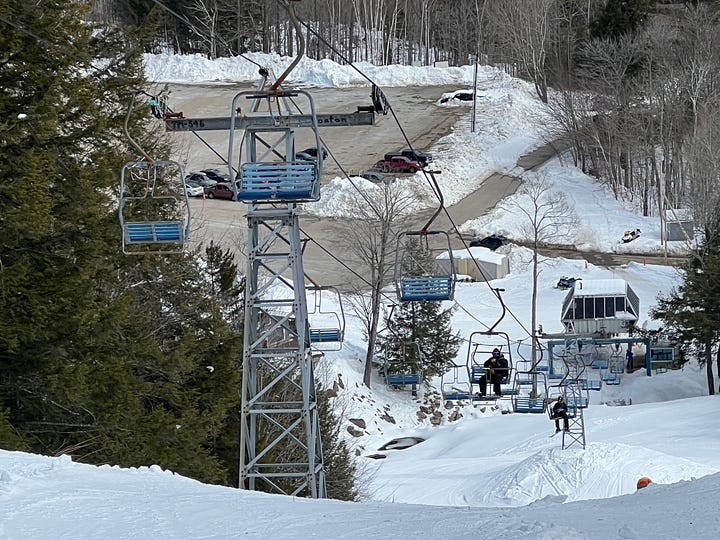
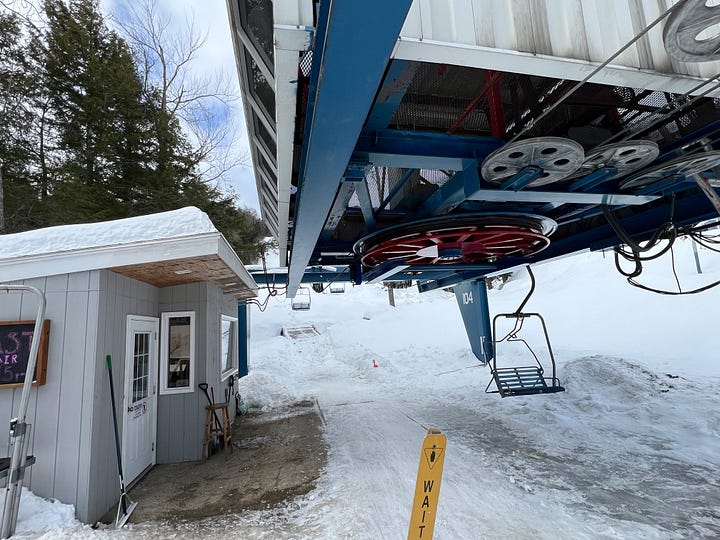
There’s the narrow, twisty trails of Ye Old New England:
And the handmade trail signs:
Of course, modernity intrudes. Tenney now has RFID, trim grooming, a spacious pub with good food. And, as you’ll learn in the podcast, plans to step into the 2020s. The blueprint here is not Mad River Glen redux, or even fixed-grip 4EVA Magic Mountain. It’s transformation into something that can compete in ski area-dense and rapidly evolving New Hampshire. The vision, as Egan lays it out, is compelling. But there will be a cost to it, including, most likely, the old Hornet. That Tenney will be a Tenney worth skiing, but so is this one, and better to see it before it’s gone.
Podcast Notes
On 30 Years in a White Haze
I mentioned Egan’s book, 30 Years In A White Haze, in the intro. I dedicated an entire podcast with his co-author, Eric Wilbur, to this book back in 2021:
On Jackson Hole’s jeans-skiing day
So this happened in December:
On the December washout
Egan references the “December washout” – this is the same storm I went deep on with Sunday River GM Brian Heon recently. Listen here.
On “what I did 20 years ago” and warm-weather snowmaking
This was Egan’s second run as Tenney general manager. His first tenure, near the turn of the century, overlapped with the ski area’s experiments in warm-weather snowmaking. New England Ski History summarizes:
In October of 2002, Tenney was purchased by SnowMagic, a company seeking to showcase its snowmaking technology. The company's origins dated back to the late 1980s, when Japanese skier Yoshio Hirokane developed an idea to make snow in warmer temperatures, called Infinite Crystal Snowmaking. Hirokane later joined forces with Albert Bronander to found the New Jersey-based SnowMagic company. A significant investment was planned at Tenney, rumored to be a choice of either replacing the 1964 Stadeli double chairlift with a high speed detachable quad or installing the high-tech snowmaking system.
In advance of the 2002-2003 ski season, the investment in a SnowMagic system was announced. The system, rumored to cost $1,000,000, would allow the ski area to stay open year round. There was some speculation that the runaway success of this new system would allow for the purchase of a high speed quad shortly thereafter. Famous skier Dan Egan served as General Manager when the area reopened in December 2002.
After dealing with equipment shipping delays reportedly caused by a longshoreman's strike, Tenney was able to open during the summer and fall of 2003 thanks to the system. Numbers were disappointing and costs were high, especially considering it was only covering a small slope. Summer snowmaking operations were cancelled in 2004 and the snowmaking system was sent to Alabama. While summertime snowmaking was expected to return to Tenney in 2005, it was all but forgotten, as the company determined the systems yielded better revenue in warmer climates.
The most recent headline-making experiment in warm-weather snowmaking landed last October, when Ski Ward, Massachusetts beat everyone to open for the 2023-24 ski season with an assist from an expensive but powerful piece of technology:
It cost $600,000. It’s the size of a shipping container. In an August test run, it cranked out a six-foot-tall pile of snow in 83-degree weather.
It’s the L60 snowmaking machine from Quebec-based Latitude 90. And it just helped Ski Ward, Massachusetts beat every other ski area in North America to open for the 2023-24 ski season.
The skiing wasn’t much. A few feet of base a few hundred feet long, served by a carpet lift. Ski Ward stapled the novelty to its fall festival, a kitschy New England kiddie-fest with “a petting zoo, pony rides, kids crafts, pumpkin painting, summer tubing, bounce houses … and more.” Lift tickets cost $5.
On potential Tenney expansions
We discuss several expansion opportunities for Tenney, including a proposed-but-abandoned upper-mountain beginner area. This 1988 trailmap shows where the potential new lift and trails could sit:
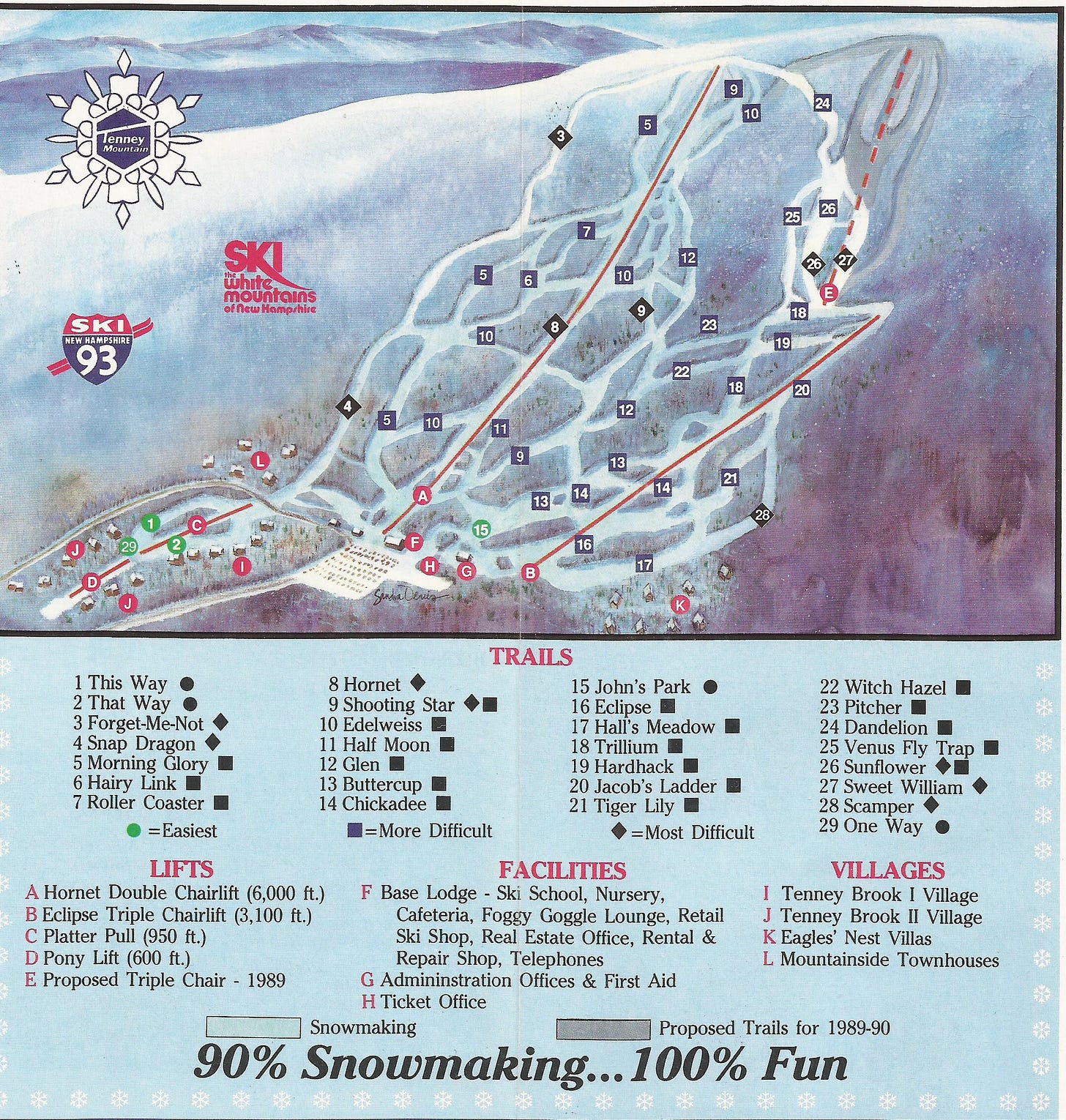
On the evolution of Loon
Loon, in recent years, has leapt ahead of its New Hampshire competitors with a series of snowmaking and lift upgrades that are the most sophisticated in the state (Waterville Valley might argue with me on that). I’ve profiled this evolution extensively, including in a conversation with the ski area’s current GM, Brian Norton, in 2022 - listen here.
On Waterville Valley’s summit T-bar
One of the most underrated lifts in New England is Waterville Valley’s summit T-bar. The story behind it is instructive, though I’m not sure if anyone’s paying attention to the lesson. Here’s the background – in 1988, the ski area installed the state’s first high-speed quad, a base-to-summit machine then known as High Country Express (the ski area later changed the name to “White Peaks Express”:

But detachable lifts were new in the ‘80s, and no one really understood that stringing one to the top of White Peak would prove problematic. Wind holds were a constant problem. So, in 1996, Waterville took the extraordinary step of shortening the lift by approximately 400 vertical feet. Skiers could still travel to the summit on the High Country double chair, a Stadeli machine left over from the 1960s:
But that lift was still prone to wind holds. So, in 2018, Waterville GM Tim Smith tried something both simple and brilliant: replacing the double chair with a brand-new T-bar, which cost all of $750,000 and is practically immune from wind holds:
The result is a better ski experience enabled by a lost-cost, low-tech lift. The ski area continued to invest heavily in the rest of the mountain, throwing down $12 million on the Tecumseh Express bubble six-pack – which replaced the old White Peaks Express – in 2022.
Video by Stuart Winchester.
On JP Auclair
Egan mentions JP Auclair, a Canadian freeskier who died in an avalanche in 2014. Here’s a nice tribute to JP from Chris O’Connell, who cofounded Armada Skis with Auclair:
There are a million things that can be said about JP as a skier—how he pioneered and transcended genres, and the indelible mark he has made on the sport. But there is so much more: he was a genuinely good human; he was my favorite person to be around because he was hilarious and because he was kind.
In the summer of 1997 I watched a VHS tape of JP Auclair and JF Cusson skiing the park at Mt. Hood. It was a time when snowboarding was peaking and, in many places, skiers weren’t even allowed in the park. Skiers certainly weren’t doing tricks that rivaled snowboarders—in difficulty or in style. To see JP and JF doing cork 720s blew my mind, and, as a snow sports photographer, I wanted to meet them. At the time, I was a senior photographer at Snowboarder Magazine and I had begun contributing with a start-up ski magazine called Freeze. The following spring the photo editor of Freeze blew out his knee and in his place, I was sent to the Nordic jib land, Riksgransen, Sweden to meet these guys.
JP and I hit it off and that’s how it began – 16 years of traveling and shooting with him. Often, those travels were the kind which involved appearances, autograph sessions and less than ideal ski situations. He would put on a smile and give it 100 percent at an awkward press conference in China when we knew Interior BC was getting hammered. He would shred the icy slopes of Quebec when duty called, or log long hours in the Armada office to slam out a product video. JP was a champion no matter how adverse or inane. That was part of what made him so good.
Ironically, JP and I had a shared sense that what we were doing, while fulfilling in context, at times seemed frivolous. We spent our lives traveling to the far ends of the earth, and we weren’t doing it to build bridges or irrigations systems or to help people have clean drinking water. Instead, we were doing it for skiing. Read the rest…
On Crotched and Peak Resorts
Egan is right, Crotched is often overlooked and under-appreciated in New England skiing. While much of the region fell behind the West, from a technology point of view, in the 2000s, Peak Resorts rebuilt Crotched almost from scratch in 2003, relocating three lifts from Virginia and installing a new snowmaking system. Per New England Ski History:
At the turn of the millennium, Midwestern ski operator Peak Resorts started looking into either acquiring an operational mid-sized area or reopening a defunct area in New England. Though Temple Mountain was heavily considered, Peak Resorts opted to invest in defunct Crotched Mountain. According to Peak Resorts' Margrit Wurmli-Kagi, "It's the kind of small area that we specialize in, but it skis like a larger mountain. It has some nice glades and some nice steeps, but also some outlying areas that are perfect for the beginners."
In September 2002, Peak Resorts formed S N H Development, Inc. as a New Hampshire corporation to begin rebuilding the former western side of the ski area. In terms of vertical feet, the prospective ski area was three times larger than any of Peak Resorts' current portfolio. After a 50 year lease of the property was procured in May 2003, a massive reconstruction project subsequently took place, including reclearing the trails, constructing a new snowmaking system, building a new base lodge, and installing rebuilt lifts from Ski Cherokee, Virginia. A reported ten million dollars later, Crotched Mountain reopened as essentially a new ski area on December 20, 2003. Though most of the terrain followed the former western footprint, the trails were given a new science fiction naming scheme.
While the reopened ski area initially did not climb to the top of the former quad chairlift, additional trails were reclaimed in subsequent years. In February of 2012, it was announced that Crotched would be acquiring Ascutney's detachable quad, reopening the upper mountain area. The lift, dubbed the Crotched Rocket, opened on December 1, 2012.
On “Rusty” in the hall of fame
Egan refers to “Rusty’s” U.S. Ski and Snowboard Hall of Fame induction speech. He was referring to Rusty Gregory, former CEO of Alterra Mountain Company and three-time Storm Skiing Podcast guest. Here’s the speech (with an intro by Egan):
The Storm publishes year-round, and guarantees 100 articles per year. This is article 26/100 in 2024, and number 526 since launching on Oct. 13, 2019.




